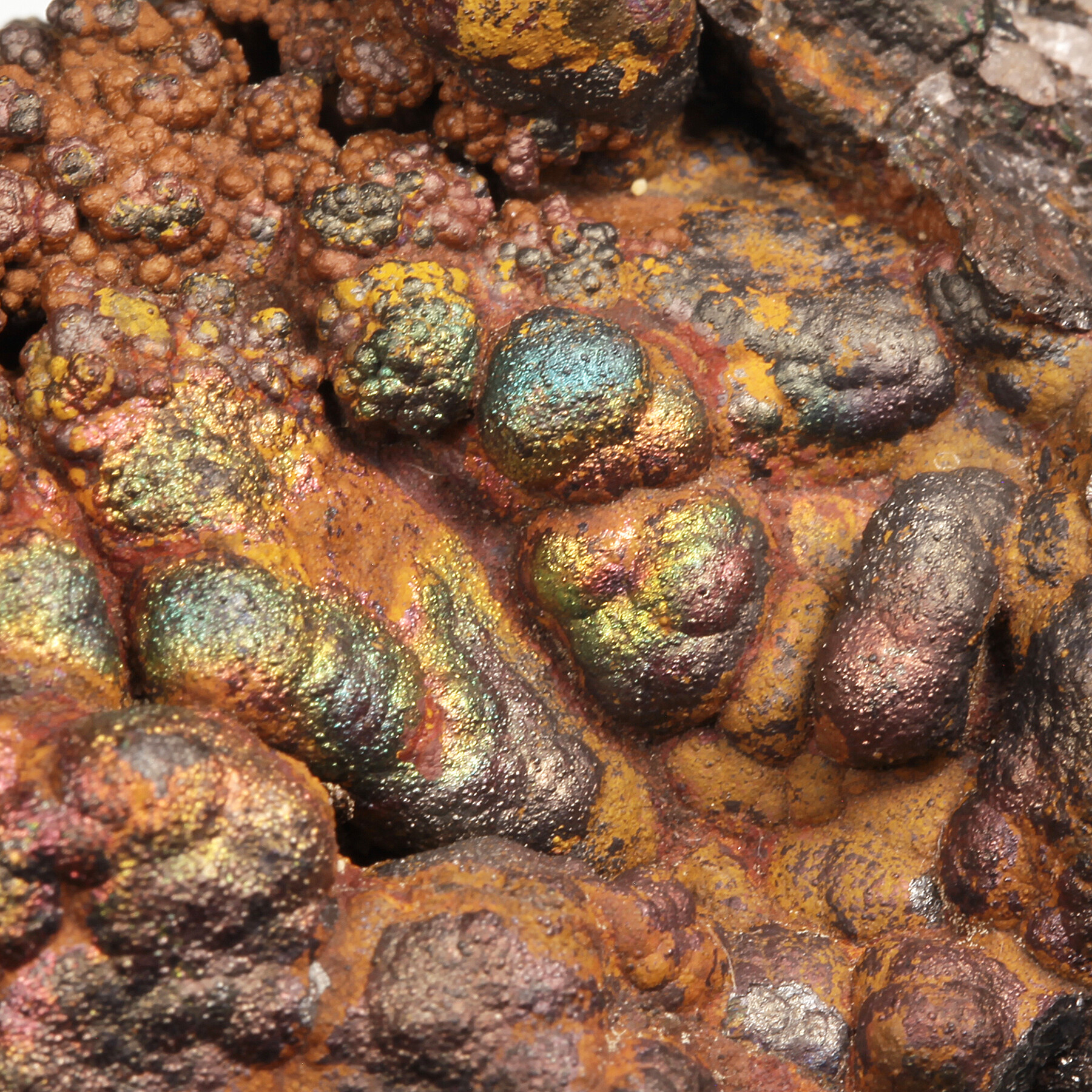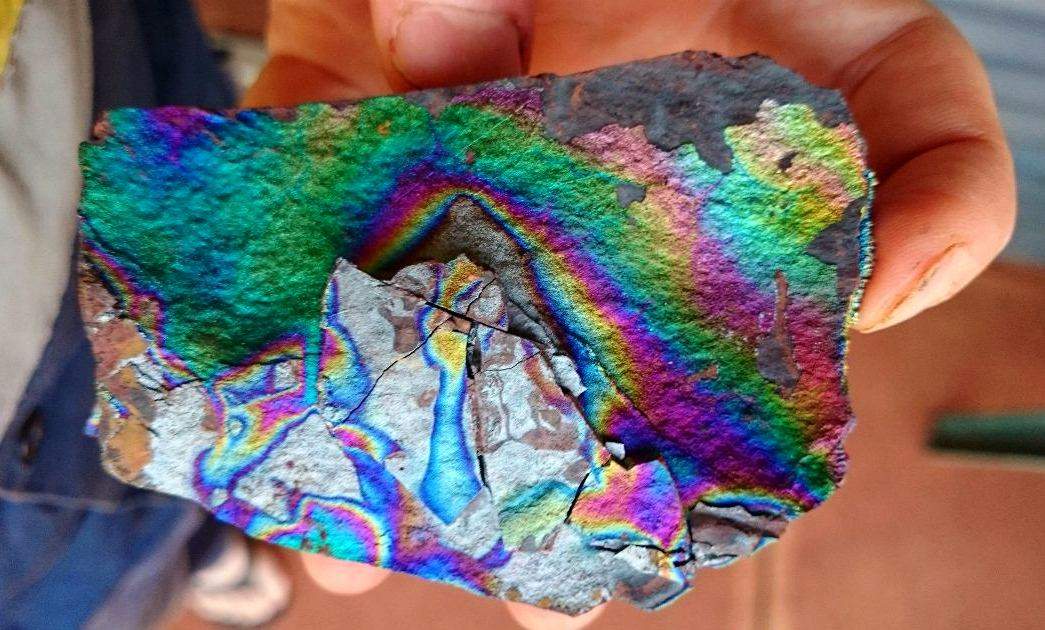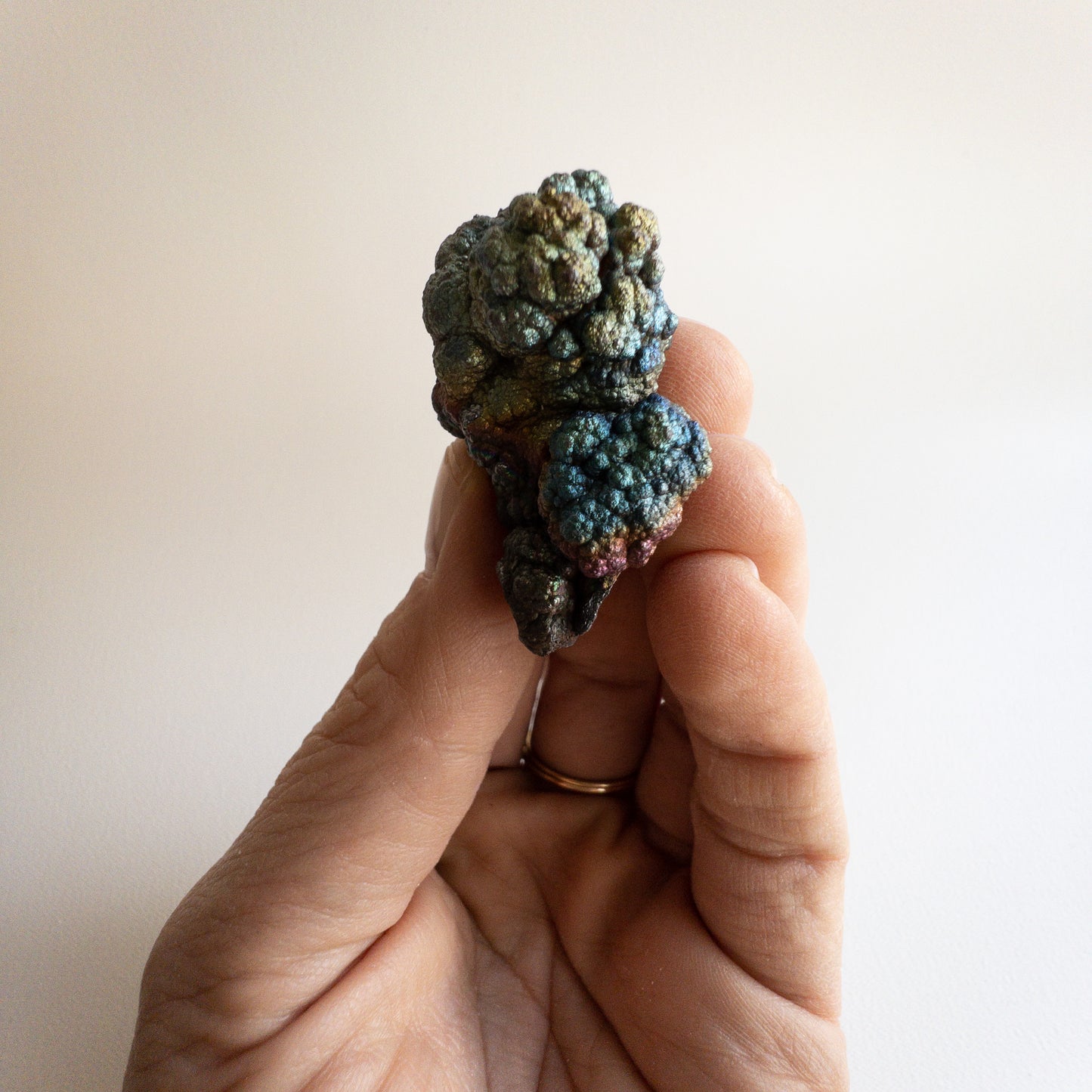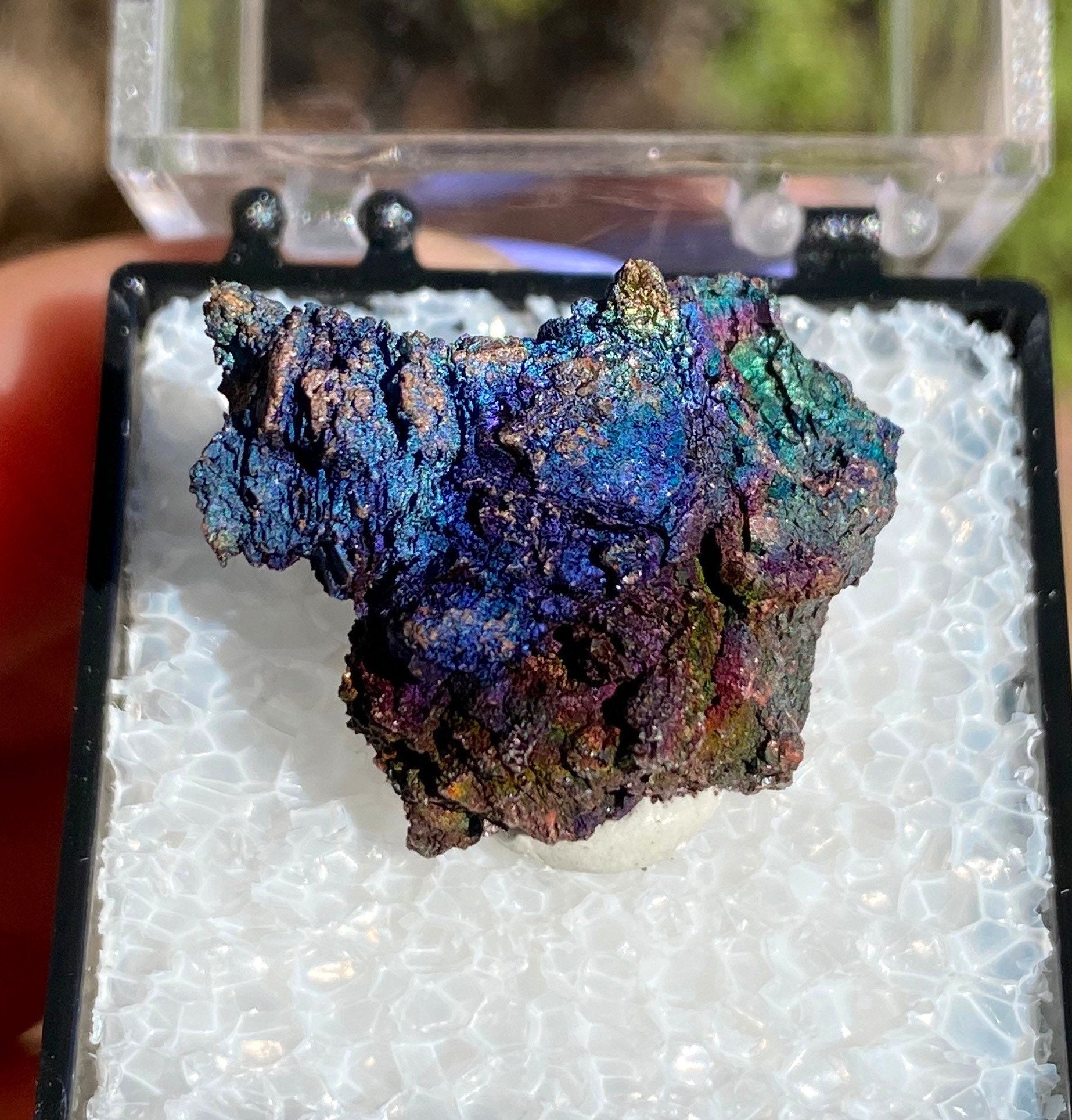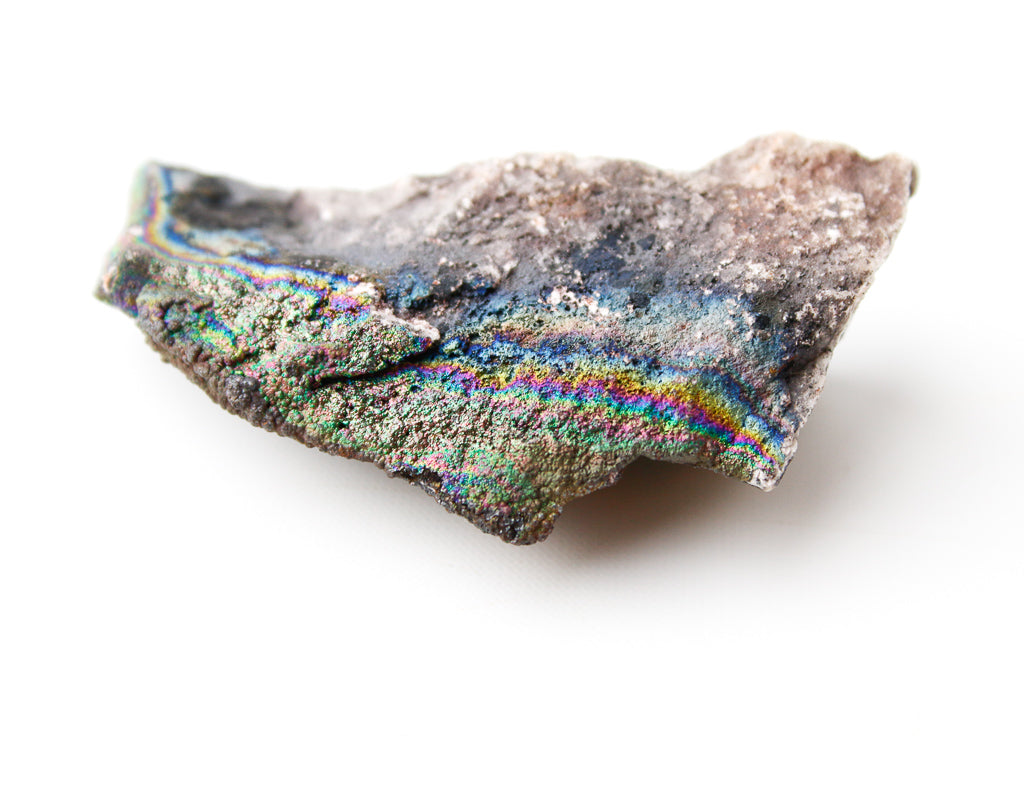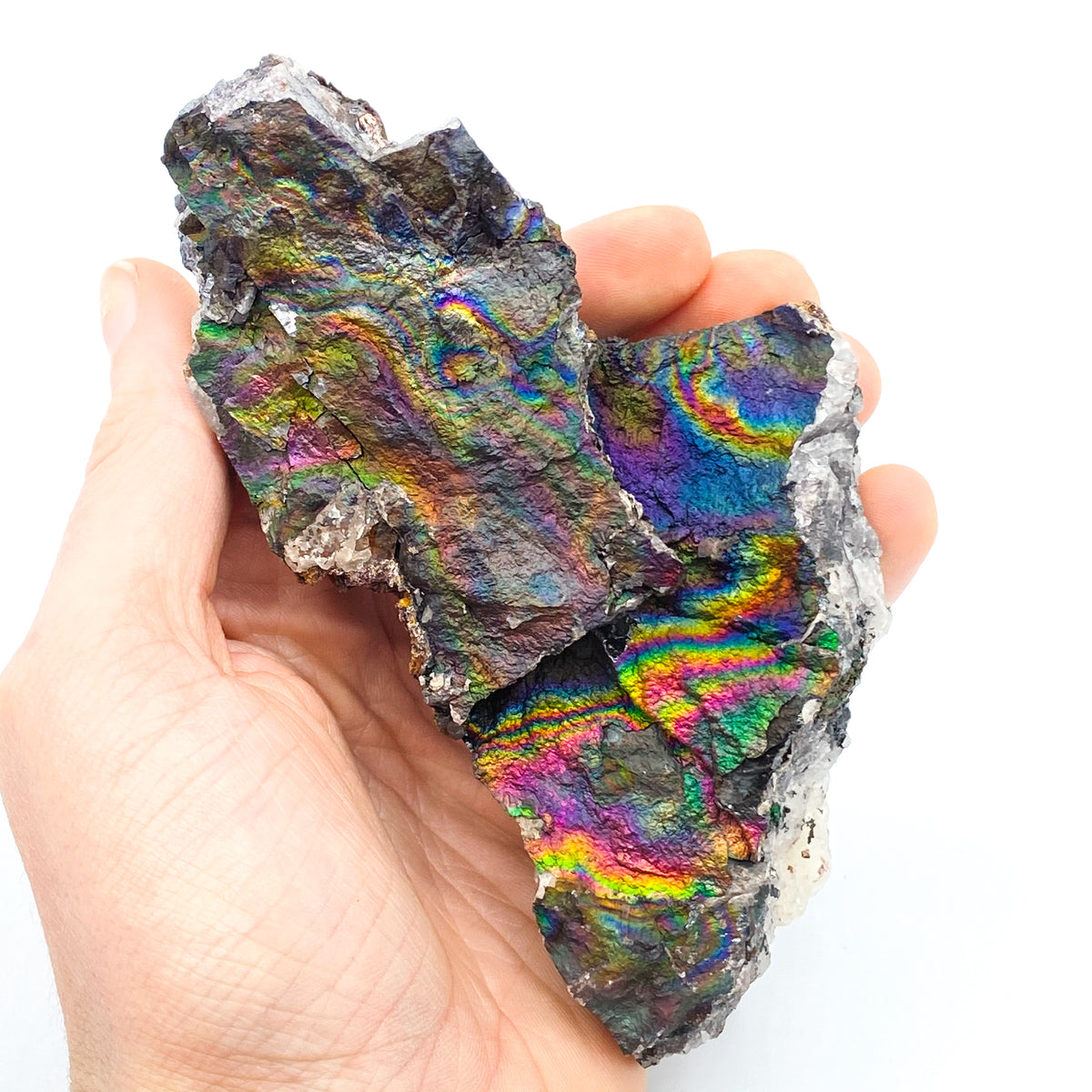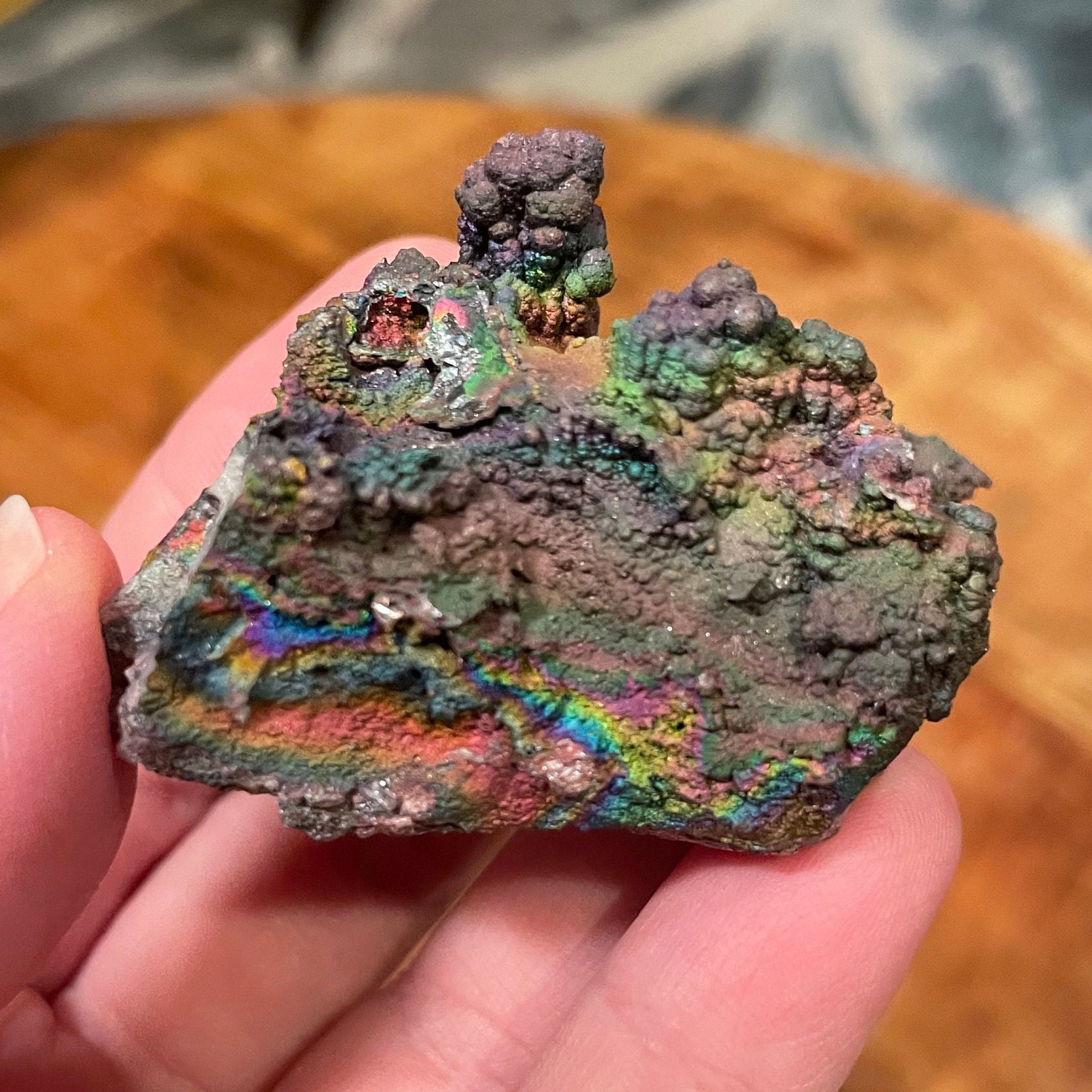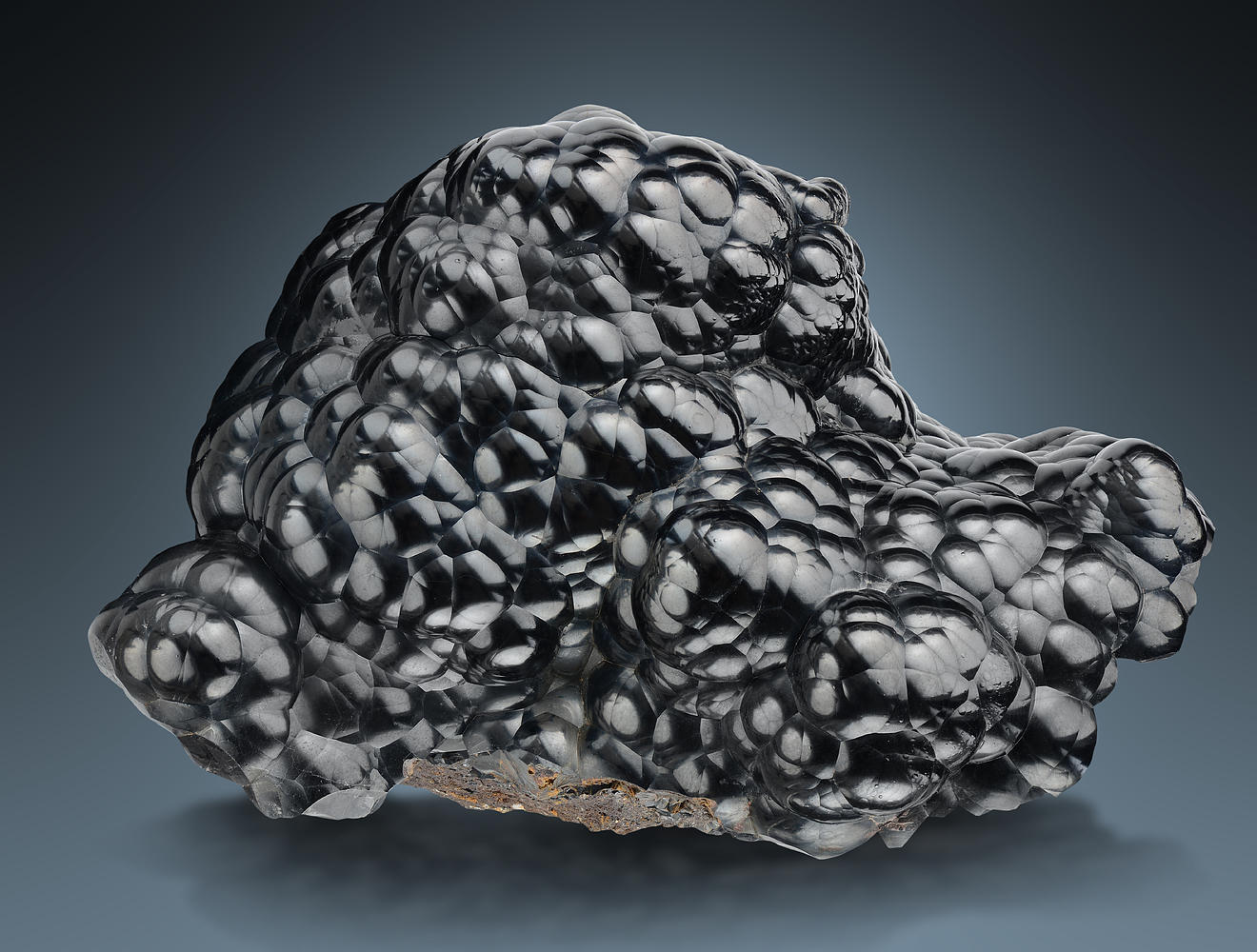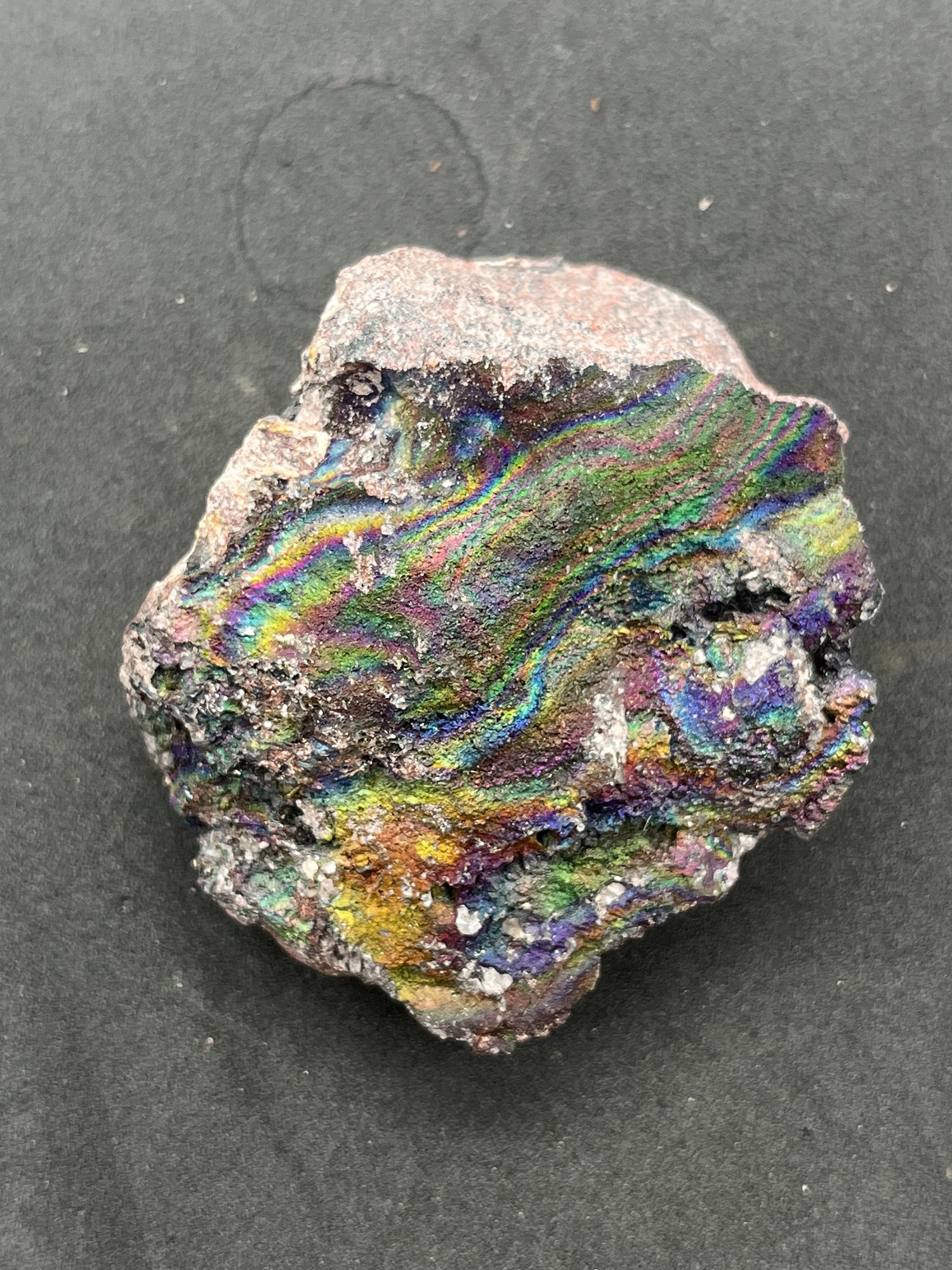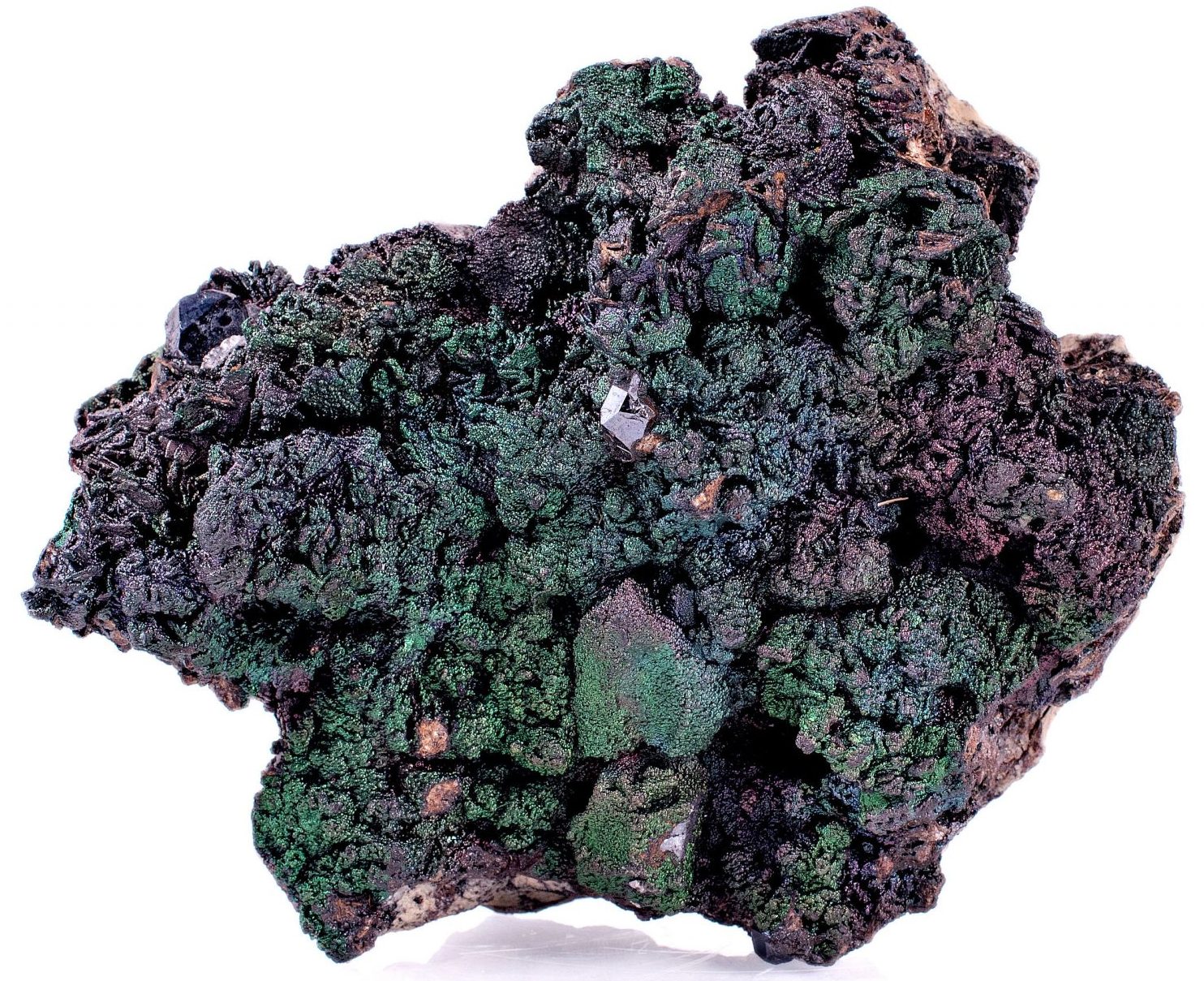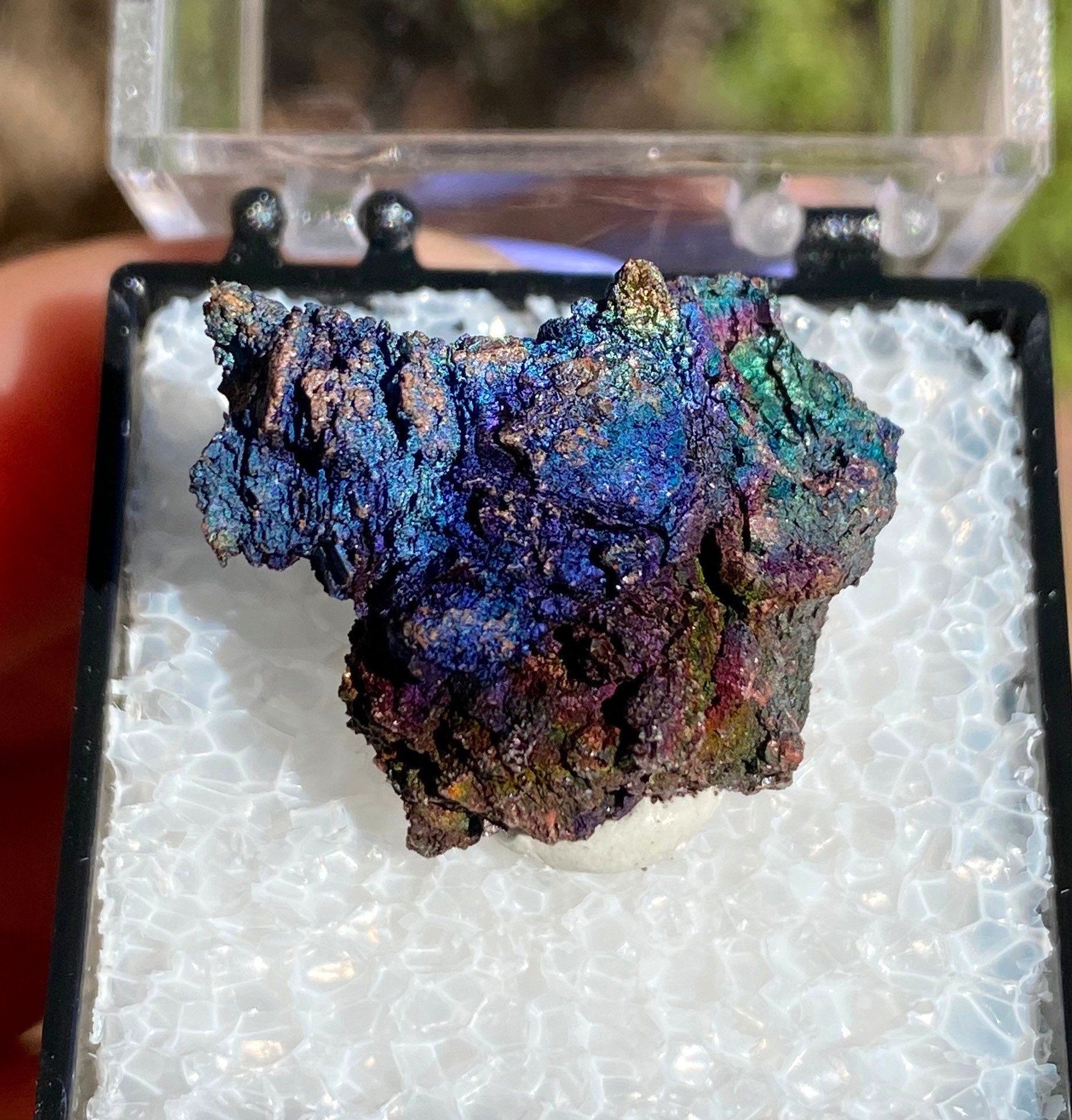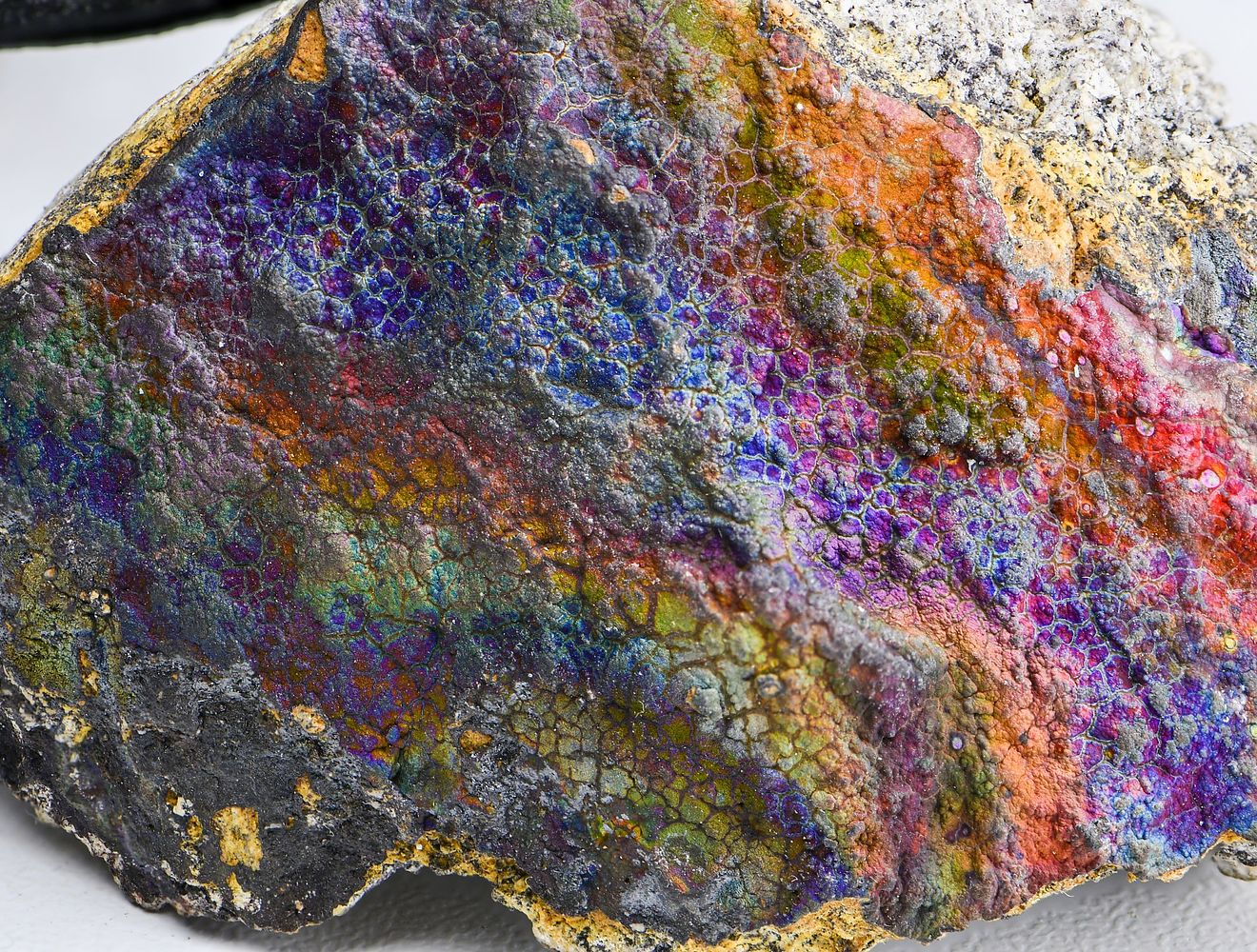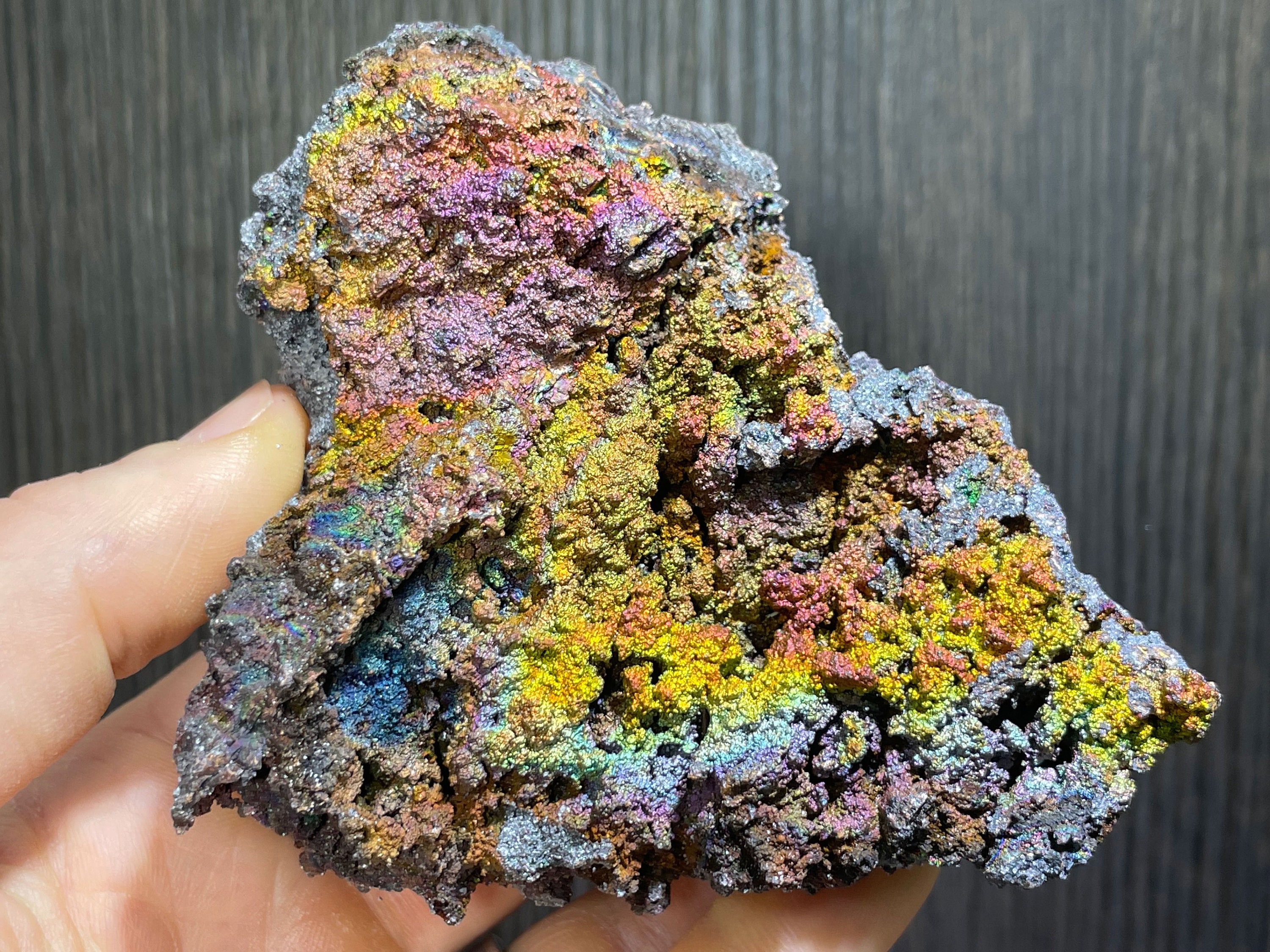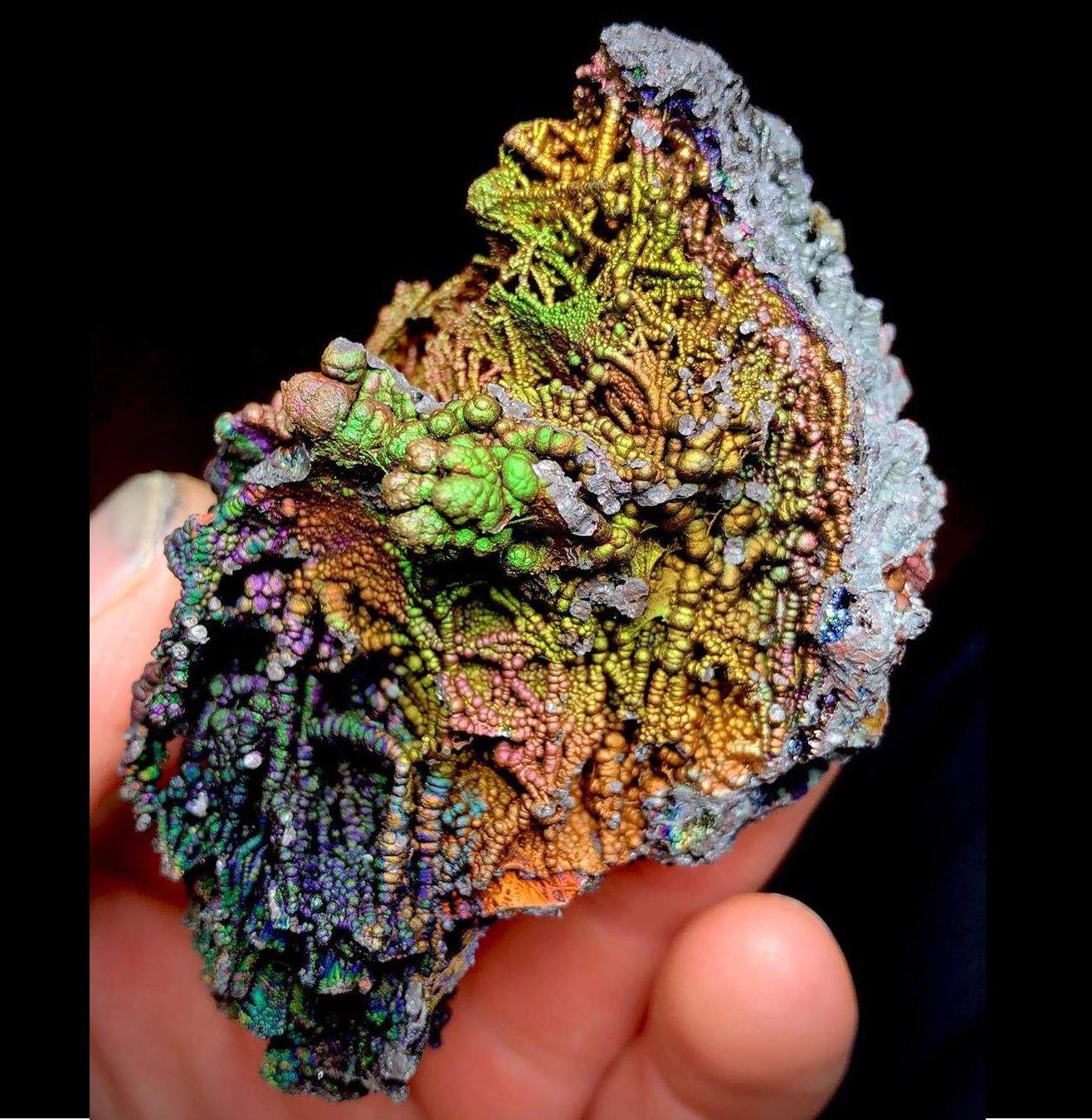
Turgite, a captivating mineral with a mesmerizing blend of colors, has intrigued geologists and mineral enthusiasts for centuries. Its name stems from the Latin word "turgens," meaning swelling, which aptly describes its characteristic appearance.
Comprising hematite and goethite, turgite exhibits a unique iridescent luster and is often found in hydrothermal deposits. This article delves into the fascinating world of turgite, shedding light on its formation, properties, and its intriguing interaction with hydrogen sulfide (H2S).
Turgite Meaning & Energy
Iridescent Goethite, also known as Turgite and Hydrohematite, crystallizes in masses, botryoidal, and stalactites. Iridescent Goethite, a powerful grounding stone, awakens the root chakra, helping you comprehend yourself.
This stone helps you live in the now by slowing down your surroundings. This mineral's iron activates your gut instincts, helping you lead with integrity. Iridescent Goethite is an excellent daily crystal or meditation crystal after a stressful day.
Turgite Formation And Composition
Turgite owes its origin to the fascinating interplay of geological processes. It typically forms as a result of the oxidation of iron-bearing minerals in hydrothermal systems, where hot water circulates through fractures in rocks.
This process leads to the precipitation of iron oxides and hydroxides, including hematite and goethite, which combine to give turgite its distinct appearance. The intergrowth of these minerals creates the characteristic iridescence, ranging from metallic blues to vibrant reds.
A Brief History Of Turgite
Let us discuss the history of turgite.
Ancient Origins And Early Discoveries
Turgite, a mineral renowned for its distinctive iridescence, traces its history back to ancient civilizations. The first recorded encounters with turgite can be found in historical texts and accounts, where it was often described as a unique and captivating mineral.
Naming And Etymology
The name "turgite" finds its roots in the Latin word "turgens," meaning swelling or rising. This name aptly reflects the mineral's characteristic appearance, which often exhibits a specific swelling or protrusion on its surface. The term was coined to capture the essence of this visually striking mineral.
Pioneering Geological Studies
The systematic study of turgite gained momentum in the 19th century as geologists began to unravel the intricate processes responsible for its formation. Early researchers meticulously examined turgite's physical properties, crystal structure, and its occurrence in various geological settings.
Turgite In Hydrothermal Systems
It was during the 20th century that a deeper understanding of the turgite's formation process emerged. Geologists identified its association with hydrothermal systems, where hot water carrying dissolved minerals percolates through fractures in rocks. This revelation shed light on the specific conditions required for turgite to develop.
Industrial Applications And Collectors' Delight
As turgite's unique visual appeal became more widely recognized, it gained popularity among mineral collectors and enthusiasts. Its vibrant colors and iridescence made it a coveted specimen, sought after for private collections and museum displays.
Turgite's Interaction With Hydrogen Sulfide
In recent decades, studies have focused on turgite's intriguing interaction with hydrogen sulfide (H2S). This chemical reaction, known as sulfidation, has opened new avenues of research in mineralogy and geochemistry, providing valuable insights into the transformative processes occurring within hydrothermal environments.
Contemporary Significance And Ongoing Research
Today, turgite continues to be a subject of interest for geologists, mineralogists, and researchers exploring Earth's geological wonders. Ongoing studies aim to deepen our understanding of turgite's formation, its role in geological processes, and its potential applications in various industries.
The Best Types Of Turgite
Turgite, a mineral formed through the oxidation of iron-bearing minerals in hydrothermal systems, exhibits a fascinating range of colors and properties. Here are some of the most notable types of turgite.
Iridescent Turgite
Characterized by its stunning play of colors, iridescent turgite is perhaps the most visually captivating type. The intergrowth of hematite and goethite layers creates a mosaic of vibrant hues, ranging from metallic blues to vivid reds.
Botryoidal Turgite
This type of turgite is distinguished by its rounded, grape-like formations. These spherical clusters can range in size from small nodules to larger, eye-catching specimens. The botryoidal texture enhances the mineral's aesthetic appeal.
Fibrous Turgite
Fibrous turgite is composed of fine, thread-like crystal formations. These delicate fibers can give the mineral a silky or fibrous texture, adding a unique tactile dimension to its visual allure.
Banded Turgite
In banded turgite, alternating layers of hematite and goethite create distinct bands or stripes. This type of turgite showcases a rhythmic pattern, often resembling the growth ringsof a tree, providing an additional layer of visual interest.
Crystalline Turgite
This type of turgite is characterized by well-defined, individual crystals. These crystals can range in size from microscopic to larger, more impressive forms, allowing for a detailed examination of turgite's crystal structure.
Drusy Turgite
Drusy turgite features a layer of tiny, closely spaced crystals covering a matrix. It creates a sparkling, glittering effect that can be particularly enchanting when viewed under proper lighting conditions.
Sulfidation Turgite
When turgite comes into contact with hydrogen sulfide (H2S), it transforms, forming iron sulfides like pyrite and marcasite. This type of turgite exhibits a distinct change in appearance and properties, highlighting its dynamic nature.
Specularity-Enriched Turgite
Specularite is a variety of hematite known for its high metallic luster. When turgite is enriched with specularite, it exhibits a particularly dazzling sheen, making it highly sought after by collectors.
Massive Turgite
This type of turgite forms in dense, solid masses without distinct crystal formations. It often occurs as vein fillings or as part of larger mineral aggregates.
Banded-Iridescent Turgite
Combining the characteristics of banded and iridescent turgite, this type showcases both rhythmic layering and vibrant colors, creating a visually captivating display.
Turgite Properties
Hematite and Goethite combine to form Turgite. It brings together all the qualities of its two stones. What makes this stone so beneficial for the circulatory system?
Turgite aids in the synthesis of red blood cells, the absorption of iron, and the prevention of blood loss. It's great for keeping you rooted and safe from the outside world. Turgite, when worn near the third eye, enhances intuition and may even facilitate " to see (clairvoyance). It is a stone of balance, both physically and mentally.
Turgite, with its captivating blend of colors and unique composition, is believed by some to possess metaphysical properties that can influence one's spiritual and emotional well-being. It's important to note that these beliefs are based on folklore, spiritual traditions, and personal interpretations and are not scientifically substantiated.
Turgite Healing Properties
Turgite, a captivating mineral with its vibrant colors and unique composition, is believed by some to possess healing properties in metaphysical and holistic practices. It's important to note that these beliefs are not scientifically substantiated and should be considered as complementary practices rather than a replacement for professional medical advice. Here are some commonly associated healing properties of turgite.
Emotional Healing
Turgite is often used for emotional healing and is believed to help release and cleanse pent-up emotions and traumas. It may offer a sense of calm and inner peace, allowing individuals to process and let go of emotional burdens.
Grounding And Stability
Many practitioners believe that turgite's grounding properties can help individuals feel more centered and stable. It is thought to provide a sense of security, especially during times of emotional or energetic turbulence.
Energizing And Revitalizing
Turgite's vibrant colors and energetic composition are believed to invigorate the spirit. It may help combat feelings of lethargy, revitalizing one's energy and motivation.
Enhanced Intuition And Spiritual Awareness
Some individuals use turgite to enhance their intuitive abilities and deepen their spiritual awareness. It is believed to open channels of insight, allowing for a greater understanding of one's spiritual path and purpose.
Protection And Shielding
Turgite is sometimes considered a protective stone, believed to create a shield of positive energy around the wearer. It is thought to ward off negative influences and provide a sense of safety.
Physical Vitality And Well-Being
While not a replacement for professional medical care, some individuals believe that turgite may support physical well-being. It is thought to promote vitality and overall healthwhen used in conjunction with proper healthcare practices.
Stress Reduction
Turgite is often used as a tool for stressreduction and relaxation. Its soothing energies are believed to help calm the mind and promote a sense of tranquility.
Balancing Energies
Turgite is associated with balancing energies within the body, particularly those related to the root chakra. This balancing effect is believed to promote a sense of equilibrium and stability.
Promoting Positive Communication
Some practitioners believe that turgite can enhance communication skills, both with oneself and with others. It is thought to encourage clear and effective self-expression.
Facilitating Personal Growth And Transformation
Turgite's dynamic interplay of minerals is sometimes seen as symbolic of personal transformation. It is believed to assist individuals in navigating through periods of change and personal growth.
Turgite Metaphysical Properties
Here are some commonly associated metaphysical properties of turgite.
Enhanced Intuition
Some individuals believe that turgite can heighten one's intuitive abilities. It is thought to open channels of insight and enhance spiritual awareness, allowing for a deeper understanding of one's inner self and the world around them.
Creativity And Inspiration
Some practitioners believe that turgite can stimulate creativity and inspire artistic expression. It is thought to remove mental blocks and encourage a free flow of ideas and inspiration.
Chakra Alignment
Turgite is often associated with the root chakra, which is located at the base of the spine. It is believed to help balance and align this energy center, promoting a sense of stability, security, and a solid connection to the physical world.
Spiritual Growth And Transformation
Some believe Turgite's dynamic interplay of minerals and colors symbolizes transformation and growth. It is thought to assist individuals in navigating through periods of change and evolution.
Enhanced Communication
Turgite can facilitate more transparent communication, both with oneself and with others. It is thought to enhance self-expression and promote effective interpersonal interactions.
Enhanced Introspection
Turgite is believed to encourage introspection and self-reflection. It is thought to aid in understanding one's true desires, motivations, and purpose in life.
Practical Applications And Uses Of Turgite
Turgite, a visually captivating mineral with unique properties, has found various applications across different industries. Its distinctive composition and aesthetic appeal make it valuable in several practical contexts. Here are some of the notable uses of turgite.
Ornamental And Decorative Purposes
Turgite's vibrant colors and iridescent luster make it a sought-after specimen among mineral collectors and enthusiasts. It is often polished, cut, and shaped into cabochons, beads, or sculptures for use in jewelry, home decor, and artistic creations.
Art And Craftwork
Artists and artisans utilize turgite in a wide range of artistic endeavors. Its unique visual characteristics, including its iridescence and intricate crystal formations, make it a favored choice for creating distinctive and eye-catching pieces of art.
Educational And Geological Displays
Turgite specimens are frequently used in educational settings and geological displays. They serve as valuable teaching tools for students and enthusiasts to learn about mineralogy, crystallography, and geological processes.
Metaphysical And Spiritual Practices
In certain metaphysical and spiritual practices, turgite is believed to possess specific energies that can influence one's well-being. It is used in rituals, meditation, and energy work to promote grounding, intuition, and emotional healing.
Lapidary Work
Turgite is a popular choice among lapidaries for its suitability in cutting and shaping. Skilled lapidaries can transform raw turgite specimens into polished gemstonesor cabochons, which can then be incorporated into jewelry designs.
Scientific Research
Geologists and mineralogists study turgite to gain insights into its formation process, crystallography, and its interactions with other minerals. This research aids in advancing our understanding of geological processes and mineral formations.
Decorative Building Materials
In architectural and interior design applications, turgite can be utilized as a decorative stone. Its unique colors and patterns can add a distinctive touch to countertops, flooring, and other design elements.
Jewelry And Fashion Industry:
Turgite, when cut and polished, can be set into various types of jewelry, including rings, pendants, earrings, and bracelets. Its striking appearance and rarity contribute to its desirability in the jewelry market.
Healing Practices
In holistic healing practices, some individuals believe that turgite can have therapeutic benefits. It may be used as a touchstone or placed on specific energy points during energy work or meditation sessions.
Cultural And Historical Significance
In some cultures, turgite may hold cultural or historical significance. It may be used in traditional ceremonies or as a symbol of particular beliefs or practices.
Turgite In Art And Jewelry - A Fusion Of Nature's Beauty And Human Creativity
Turgite, with its mesmerizing blend of colors and unique composition, has long captured the imagination of artists and jewelry designers around the world. This captivating mineral, formed through the oxidation of iron-bearing minerals in hydrothermal systems, possesses an iridescent luster that lends itself beautifully to artistic expression.
Turgite As A Muse For Artists
Artists find inspiration in the vibrant and dynamic patterns of turgite. Its intergrowth of hematite and goethite creates a visual symphony of metallic blues, vivid reds, and iridescent hues that evoke a sense of wonder and awe. Many artists are drawn to turgite's ability to mimic the grandeur and intricacy of nature itself.
In the hands of skilled painters, turgite's captivating colors find their way onto canvases, immortalizing the mineral's beauty in fine art. Its radiance, in particular, presents a unique challenge and opportunity for artists to capture the ever-changing play of light and color.
Turgite In Sculpture And Craftsmanship
The malleability of turgite allows skilled sculptors to shape and carve it into intricate forms. From delicate figurines to bold, statement pieces, turgite can be sculpted to reflect both the organic and geometric aspects of the natural world. These sculptures often become coveted pieces among collectors and enthusiasts for their aesthetic and symbolic value.
Turgite In Jewelry Making
Turgite's beauty extends to the world of jewelry, where it is transformed into wearable works of art. Skilled lapidaries carefully cut and polish raw turgite specimens, revealing their inner brilliance. These polished stones are then set into various types of jewelry, including rings, pendants, earrings, and bracelets.
Jewelry designers appreciate turgite's unique and captivating appearance. Its vibrant colors and iridescent luster make it a favored choice for those seeking to create distinctive, eye-catching pieces. Turgite's presence in jewelry elevates it beyond mere ornamentation, infusing it with a sense of natural wonder and artistic expression.
Turgite's Role In Sustainable Jewelry
Turgite's formation process, rooted in geological history, aligns with the principles of sustainability and eco-consciousness. Using turgite in jewelry allows for a connection between the wearer and the Earth's ancient processes, creating a deeper appreciation for the natural world.
Collecting Turgite Art And Jewelry
For collectors and enthusiasts, turgite art and jewelry hold a special allure. These pieces not only showcase the inherent beauty of the mineral but also serve as a testament to the creativity and craftsmanship of the artists and designers who work with it. Turgite jewelry and art can become cherished heirlooms, passed down through generations, carrying with them a sense of wonder and appreciation for the Earth's geological wonders.
Turgite - FAQs
What Is Turgite Good For?
Hematite with Goethite form turgite. Rainbow Hematite removes all negativity and grounds high vibrations during healing. Negative Rainbow Hematite becomes love.
What Gives Turgite Its Color?
The iron-oxide layer on this mineral makes it rainbow-colored. Turgite was formerly considered a mineral. However, some geologists disproved it. They call it a hematite-goethite combination. All of these minerals are iron oxides.
Where Is Turgite Found?
Turgite, a rare mineral, is found in the US, Canada, Europe, and Australia. The Ironwood Iron Formation in Michigan, the Labrador Trough in Canada, and the Erzgebirge Mountains in Germany are essential turgite deposits.
Is Turgite Rainbow Hematite?
Turgite was formerly a legitimate mineral species, but it is now classified as Hematite or Goethite (or a mixture of these two iron oxides), occasionally with botryoidal habit and rainbow iridescence.
Is Turgite A Mineral?
Irridescent turgite is a combination of two minerals, hematite, and goethite, and arises owing to an alteration of the goethite. It arises only under particular environmental circumstances. Turgite is not regarded as a mineral unto itself since it is a combination of two minerals.
Conclusion
Turgite, with its captivating blend of colors and unique formation process, stands as a testament to the intricate geological processes that shape our planet. Its interaction with hydrogen sulfide unravels new dimensions in mineralogy, shedding light on the dynamic interplay between minerals and their surrounding environments. As we continue to explore the depths of Earth's geological wonders, turgite remains a gem that continues to inspire curiosity and fascination among geologists and mineral enthusiasts alike.
